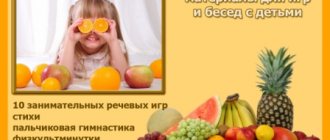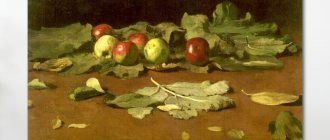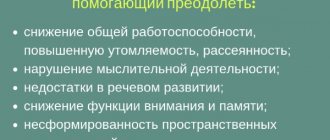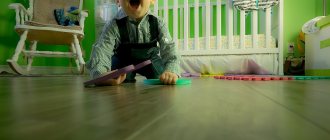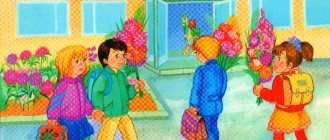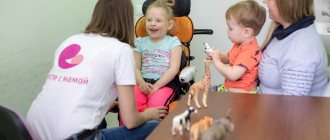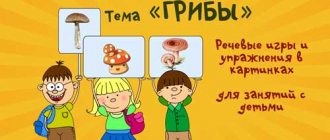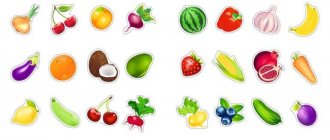Fruits:
materials for games, conversations and activities with preschool children. Finger gymnastics. Entertaining speech exercises and games for children. Physical education minutes. Cartoons.
In this article you will find:
- Conversation about fruits.
- 10 speech games on the topic “Fruits”.
- Finger gymnastics.
- Three ideas for physical education minutes.
Additional material for the article - riddles about fruits can be found in the article "Riddles"
Conversation about fruits L.K. Schleger. 1913
Preparing for the conversation.
There are different fruits in front of the children. They name them, determine their shape, colors. Determined by touch and taste with eyes closed.
Catalogs of fruits should be at hand; drawings in paints (that is, color pictures); artificial fruit
Conversation.
What do fruits grow on? What is the name of the tree on which apples grow? Can plums grow on an apple tree? What does a ripe apple look like? What does it taste like? (Sweet, juicy). Who colored the apple so much? What protects the apple pulp? (Skin). When is the apple ripe? The beauty of an apple tree hung with ruddy apples. Has anyone ever seen an apple tree with apples? What are the apples sitting on?
Who can tell me how an apple grows? Is it always so big and ruddy? What color is an unripe apple? What does it taste like? Before the apple appears, the apple tree blooms. When does it bloom? In the spring. Has anyone seen an apple tree in bloom? We'll look at it in the spring, but for now let's look at the picture.
Let's see what's inside the apple , cut it - one lengthwise, the other across. What are the seeds in and how many are there? Why do apple trees need seeds? Why do you need pulp? She guards the seeds. What color are ripe seeds? What about the unripe ones?
What kind of seeds do cherries have? At the plum?
Who eats ripe fruits? Do some people eat and love them? Do people eat seeds? They spit them out. What do birds eat? Seeds fall on the ground, and what grows from them?
What do you sometimes find in apples, pears, plums? Worm. How did the worm get into the apple tree? Does the worm remain in the apple? He gnaws it and comes out (find an apple with a worm in it). A worm is made into a pupa, and a pupa is made into a butterfly.
What do we make from fruits? What do we make jam from? Has anyone ever seen dried fruit? Show and try. What else is made from fruits? Kvass, liqueur.
Do we grow grapes? What do they make from it? What other fruits do you know that grow in warm countries? Oranges, tangerines, lemons. Are the skins of oranges and lemons as thin as those of an apple?
What fruits does an oak tree or a Christmas tree have? Who collects and eats them? Is this fruit?
Children's work on the topic "Fruits".
- Modeling fruits, drawing them.
- Cutting and pasting (applique).
- Cutting out pictures of fruits from catalogs and magazines.
- Illustration “Apple picking”.
- Fruit stand (making a model for children's games together with the children)
Question for educators to consider:
Exactly 100 years have passed since the publication of this conversation for young children by the talented teacher Louise Karlovna Schleger! Have we and our children changed? What is different about the conversation about fruits by L.K. Schleger from modern conversations about fruits in kindergarten? What requirements for a conversation with children were taken into account when compiling this conversation? What would you change about it?
You will learn more about conversations with children and about our history of methods for developing children’s speech from the article “Conversation in kindergarten” based on materials from the book by E.A. Flerina “The Living Word in a Preschool Institution.”
Lesson: fruits, healthy foods, junior group 1
Summary of a lesson on the surrounding world in junior group 1 “Vegetables and fruits are healthy foods”
Integration of educational areas: “Cognition”, “Communication”, “Physical Education”, “Health”.
Types of children's activities: gaming, communicative, motor.
The purpose of the teacher’s activity: to form in children ideas about vegetables and fruits and their beneficial properties for humans.
Tasks of the teacher:
1. To form in children ideas about vegetables and fruits as vitamins beneficial for health ;
2. To consolidate children’s knowledge about the characteristic features of vegetables and fruits : color, shape, taste;
3. Develop children's sensory sensations;
4. Form an idea of caring for your health.
Planned results of the development of integrative qualities of a preschooler: emotionally and interestedly follows the development of action in games (the meeting of Stepashka and Piggy); answers the teacher’s questions; uses different methods of examining fruits and vegetables ; shows positive emotions during physical activity.
Materials and equipment: dolls Stepashka and Khryusha, dummies of vegetables and fruits , a basket, 2 plates, illustrations of trees and beds, natural fruits and vegetables .
Speech games with preschool children on the topic “Fruits”
Game 1. Ladder in the garden. Choose a word.
Together with your child, come up with as many words as you can about what kinds of fruits there are. For example, today we will play with the word “apple” - “What kind of apple can there be?”, and next time with the word “pear” - “What kind of pear can there be?” You can choose words on the road, on a walk, on the bus or in the car. But the best thing is to play!
How to generate interest in a word matching game?
Speech exercises are difficult for children, so it is best to carry them out in a playful way and so that the child can clearly see the result of his efforts. I came up with my own technique for this - “visual game assessment of the result of speech.” This is how I do it.
I usually draw a large tree on an easel with a felt-tip pen (you can also draw a tree on a piece of paper or on a board). On the tree I draw fruits, but they must be drawn very high from the ground. There is a ladder next to the tree. The staircase is drawn as two vertical parallel lines. But - this is important - there are no steps drawn on it!
How we play: we select words and climb up the stairs to get fruit. One word = one step.
As soon as we have chosen one word, I draw one step. We found another word - I draw another step. How many words were chosen - so many steps appeared on the ladder! With each word, more steps are added, and we climb higher and higher (you can rearrange the children’s figures according to the image of the ladder). The task is to get to the top of the tree, and for this you need to choose a lot of words!
There should definitely be a pleasant surprise waiting for children at the top of the tree! When children take an apple (or plum) from the crown of a tree, on the back of the picture they should find something - a plan indicating the place where a surprise is hidden, a riddle, a small gift, a beautiful piece of paper, words of congratulations from the Gardener, a drawn medal, magic words etc.
Hint for adults
Words for the game: fragrant, big, tasty, tasteless, sour, sweet, rosy, tender, fragrant, juicy, bulk, red, yellow, golden, striped, ripe immature, ripe, round, oval, elongated, soft, hard, rotten , wormy, dried, large, small, boiled, summer, early, early ripening, southern.
Helpful advice:
- It is better if you say in this game words that are rarely found in everyday communication (“fragrant apple”, “fragrant apple”, “ripe apple”), and the children will select simpler words (“sweet apple”, “round apple”) ", "ruddy apple"). If children find it difficult, then you can suggest words to the kids with a gesture, suggest the first syllable, remind them of a familiar line from a poem in which this word appears
- This game is difficult for children at first. But later, interest and attention to words and expressive speech develops. Children begin to be very attentive to the words and literary texts that are read to them, listen to the speech of adults and notice vivid figurative epithets in it. Therefore, the game is very useful for developing attention to language, for enriching and activating children’s vocabulary, and for preparing for school.
- I really love reading Y. Akim’s poem to children, which contains many expressive epithets. Listen to it as a child and find beautiful, special, expressive words in it.
“The apple is ripe, red, sweet, the apple is crisp, with a smooth skin. I’ll split the apple in half, I’ll share the apple with my friend.” (Ya. Akim).
Here are more poems about apples, in which there are many beautiful figurative words for speech play.
Fragrant, rosy, Some are sweet, some are spicy, Some are sour, some are tart, Some are soft, some are strong. There are fresh, dried, and even soaked.
The most important sweet fruit grows in our garden. It is amber and fragrant, sweet and sour, golden. Large, round and crispy, the King's son is real! There is one with a ruddy side and a cheerful worm. Our apple tree amazingly gave us a lot of apples: very sweet, aromatic, and so pleasant to the taste.
Game 2. I know.
The first player begins: I know a lot of fruits: an apple. The second player continues: I know a lot of fruits: apple and pear. The third builds the chain further: “I know a lot of fruits: apple, pear and plum.” The task is to continue the chain and not confuse anything. An adult can make a deliberate mistake in a game, for example, naming a vegetable instead of a fruit. Will children notice this mistake?
The game develops attention and memory.
Tips for playing the game:
For children, the chain should not be too big! If there are a lot of children playing, then it is better to compose not one long chain of words, which is difficult to remember, but several chains.
When making a chain, you can string large wooden parts onto a cord. This way we can clearly see how many words we have remembered and selected.
Game 3. Let's collect fruits in a basket.
Each player names one fruit. If he named correctly, then he puts the cube in the basket. One word is one cube. The task is to fill the basket with words - cubes, remembering and naming as many fruits as possible. You can play against the clock - you need to fill the basket in 2 minutes. This is a fairly long period of time, sufficient to complete the task.
What children can name: apple, pear, quince, cherry plum, shadberry, apricot, peach, plum, lemon, orange, grapefruit, tangerine, pomegranate, pineapple, persimmon, banana, mango, avocado, kiwi and other fruits.
You can “put” in the basket not only the names of fruits, but also phrases. For example: “fragrant apple” - put a cube. Now we need to come up with the next phrase - “golden pear”. Next is a new phrase – “blue plum”. And so we fill the basket.
Game 4. Classification. Fruits and vegetables.
Children are given pictures of mixed fruits and vegetables. You need to put fruits in one basket and vegetables in another.
Be sure to ask your child: “Why do you think this is a fruit?”
To summarize children’s ideas about fruits and clarify the general concept of “fruit,” with children 4 years of age and older, you can conduct an exercise with pictures to develop logical thinking, “What are fruits?”
Step 1. Place 3-4 pictures of fruits in front of the child. For example, apple, pineapple, banana, plum. You can also use real fruits or dummies. Ask what's different
these items?
Let the child compare
them with each other and tell them that they differ: a) in color - “the plum is purple and the apple is scarlet”, b) in size “the plum is small and the pineapple is large”, c) the nature of the surface (smooth, rough), d) shape (round, oval, long - short).
Step 2. After this, ask the main question: “ How are these pictures similar?” What do these items have in common?
" It's a difficult question. If necessary, help your child with guiding questions.
- What do people do with them? Are eating. So, they are similar in that they are what? Right! Edible.
- Where do they grow?
Yes, they all grow not on the ground, but on trees, in the garden. - Can they grow on their own in a field or forest?
No. Who planted them? Human! Can they grow without care or watering? So how are they similar?
Step 3. After discussion, conclude with your child that all these pictures depict plants - fruits. And again discuss the main characteristics of fruits. Fruits are plants, they are always edible, they grow in the garden, they are planted and grown by people, people take care of them. People make jam, compotes, jellies, marmalade and other delicious treats from fruits.
Step 4. Ask them to select fruits from pictures of different foods. Why is this a fruit, you ask? Maybe it's a vegetable? Emphasize the difference - fruits grow on trees in the garden. And vegetables grow on the ground in the garden.
Game 5. What is made from fruits? Cheerful cooks.
At the beginning of the game, we remember all the dishes that are made from fruits. Remember the most favorite dishes of your children and your family.
Hint for adults: juice, compote, jelly, fruit drink, jam, jelly, marmalade, candied fruits, raisins, dried apricots and other dried fruits, Turkish delight are made from fruits. Do you remember anything else? I will be glad to see your additions in the comments after the article.
And then we start playing with the children - “cooking” their favorite dish. For example, let's make marmalade. We depict how we stir the mass in a saucepan, how we spread it with a spoon on a baking sheet, and then cut it into slices with a knife and treat the toys. And at this time we talk about marmalade, learning to form adjectives from nouns.
Let's make marmalade from different fruits, and we will succeed (we start the phrase, and the children suggest the answer). Apple marmalade - what should we call it? Apple.
- Plum marmalade – what kind? Plum. (A common mistake is “creamy”! Please note to the child that creamy is made from cream. And made from plums is plum)
- And from pears? Attention! There are common mistakes here, the correct option is pear.
- And what kind of peaches? Peach!
- From apricots - ? Apricot.
- From orange - ? Orange.
- From tangerine - ? Tangerine.
And then we start playing in the cafe. Each time we don’t just say a word, but depict a whole scene - we treat visitors, taste it, lick our lips, make suggestions, ask questions. And at this time we say: “Oh, how fragrant our apple marmalade turned out. Would you like to try the pear one? Maybe you’ll like plum better?” If a child makes a typical mistake, for example, says “apple” instead of “apple,” then it is best to treat the guests – the toys – with apple marmalade, saying this word many times in the game in different phrases: “Would you like to treat yourself to apple marmalade? It is very tasty!". Or: “Our apple marmalade is very aromatic and not cloying, you will like it!”
One of the options for such a game is to persuade the character to try apple marmalade, praising it in every possible way. And each time repeating its name and reinforcing the correct version of the word in speech. Naturally, at first the toy refuses, and then agrees. And she really, really likes apple marmalade. And your baby, while playing, masters a new word for him, and will no longer make mistakes in it! And before you know it, you will learn to speak grammatically correctly!
In the future , you will only need to remind him of the correct option in everyday communication: “Remember, we played with fruits. What is the correct name for apple marmalade? Correct your mistake. What a clever girl! Yes, apple!” Never repeat your child's mistakes. It is very important for a child to hear grammatically correct speech from adults!
Game 6. Call me affectionately.
- Apple - ? Bullseye.
- Plum - ? — Slivka
- Apricot - ? - Apricot.
- Pear - ? - Grushka.
- Orange - ? - Orange.
- Mandarin - ? - Tangerine.
- Lemon - ? Lemon.
Game 7. Wizards.
Give your child a magic wand and let him turn into a wizard. An ordinary pencil wrapped in foil can act as a stick. For beauty, you can attach a brush, bell or other attribute of magic to the pencil.
The task of our little wizards is to grow a lot of fruit. An evil wizard bewitched the garden, and only one apple grew in it. But our little wizard waves his magic wand, and a lot of things happen? Apples!
- There was one plum, a wave of the stick, and it turned out to be a lot? Drain.
- Instead of one orange, many grew? Oranges.
- There was one pineapple, but now there are a lot of other things? Pineapples.
- There was one pear. Has it become too much? Grush.
- There was one banana hanging on a branch, but now there are a lot? Bananas.
In this grammar game, your child gets to know the genitive plural of nouns. You will be able to see and correct common grammatical errors. For example, children may say that there are a lot of “apples” instead of the correct version of “apples.” Children often say that there are a lot of “pears” or “pears” instead of the correct version of “pears”. If the kids make mistakes, then play the following game with them to consolidate their speech skills.
Game 8. What happened.
Place 6 pictures in front of your child. Each picture depicts fruits: bananas, apples, pears, plums, pineapples (you can take another list of pictures). Let the baby close his eyes, and at this time you remove one of the pictures. What's missing? Grush.
In this game, the child also learns to correctly use words in the genitive case.
Visual material (pictures)+ for this game and other games in the article
has already been posted in the section of the website “Library of games, pictures and materials for activities with children” - “Fruits: pictures for children, tasks, speech games.”
Game 9. Fourth wheel.
- Lemon, tangerine, orange, cucumber.
- Pineapple, boletus, apple, pear.
- Pear, plum, fruit, kiwi.
- Plum, pear, compote, apple.
Be sure to ask children why they chose this particular word as extra. Children have their own logic, and it also has the right to life! In addition, the ability to explain and prove one’s point of view, to build arguments is very important in life and begins to develop in a child in preschool age! Take advantage of these baby development opportunities!
Game 10. Guess who?
This entertaining and fun game makes it very easy to learn how to use genitive plural nouns correctly. It happens so naturally! Children love to play, they play the game many times, and each time they develop and consolidate their speech skills without any teaching, boring exercises or long explanations - naturally and playfully!
To play you will need pictures, each of which depicts several fruits. You need two identical sets.
One of the children is the leader. He is given one set of pictures. All participants in the game take a picture from another set.
The presenter's task is to guess who has what. The dialogue goes like this:
— Do you have lemons? No, I don't have lemons! Do you have oranges? No, I don't have any oranges ! Do you have apples? No, I don't have apples ! Do you have pears? No. I don't have pears! Do you have tangerines? Yes, I have tangerines.
It is discussed in advance how many questions the presenter can ask one player. Usually this is 4-5 questions. If he was able to guess, then the children change roles in the game. The presenter becomes the player, and the child whose picture was guessed goes on to guess further.
If the presenter has not guessed right after 4 questions, then he continues to guess.
You can play this game together with your baby. Then the adult asks questions, and the child answers. Then switch roles.
Summary of an integrated lesson in the middle group on the topic “Orchard”
Goal: To form children’s ideas about fruits.
Tasks:
- Strengthen children’s ability to classify objects on the topic “Fruits”;
- Develop visual attention and perception;
- Develop children's coherent speech and logical thinking;
- Develop observation, fine and gross motor skills, taste analyzer;
- Develop communication skills.
Educational areas: “Speech development”, “Physical development”, “Social and communicative development”, “Cognitive development”.
Methods:
- Verbal (questions for children, explanation of tasks, riddles about fruits, poem about fruits)
- A surprise moment (letter from the gardener)
- Visual (multimedia presentation, cards with pictures of fruits)
- Plastic sketches “What a gardener can do”
- Gymnastics for the eyes “Guess the riddle, find the answer picture”
- Physical education
- Game "Identify by smell"
- Didactic exercise “Fruit jam”
- Self-massage of palms “Plum”
- Didactic game “What’s missing here?”
- Didactic game “What did the artist mess up?”
Facilities:
- multimedia equipment;
- multimedia presentation;
- audio recording by E., S. Zheleznov “Bus”
- letter
- pictures of fruits
- bags with pieces of fruit (orange, apple, banana, grapes)
- ball
- massage balls
- basket of apples
- gardener costume (for teacher)
Preliminary work: examination of the album “Fruits” and dummies of fruits; modeling “The apples are ripe in the garden”, drawing “Fruit basket”; reading fiction: the poem “Apple Tree” by N. Zabila, “Our apples are ripe...” by S. Ilyina, “Watermelon” by Z. Aleksandrov, “Fruit” by G. Davydov, V. Suteev “Sack of Apples”, L. Tolstoy “Bone ", conversation "Vegetables and fruits are healthy products"; didactic games “Describe, we’ll guess”, “What’s extra? ", "Collect a picture"; role-playing games “Fruit stall”, “Cooking dinner”; outdoor games “There is a scarecrow in the garden, there is a scarecrow”, “Edible - inedible”, finger games “Orange”, “Fruit palm”.
Progress of the lesson.
Motivation. There's a knock on the door. The postman delivers a letter. Educator: Guys, look, someone sent us a letter. Let's read it. "Hello guys. The gardener Ivan Ivanovich is writing to you. I need your help: harvesting the garden. I’m looking forward to your visit.” Educator: Guys, do you want to help the gardener harvest? Children: yes. Educator: What will we go on? The fastest way for us to get there is by bus. (Offers to build an impromptu bus from chairs) Educator: Get on the bus, guys, let's go faster. (Music by E., S. Zheleznov “Bus” sounds. Children sit on chairs and imitate a bus ride.) Educator: Here we are! Gardener: Hello! I'm so glad you came to visit me! Guys, do you know who a gardener is? Children's answers. Gardener: Now I will ask you to show what a gardener does in his garden? I will tell you tasks, and you will try to portray them. Ready?
Plastic sketches “ What a gardener can do.”
Children use movements to depict actions that the gardener calls:
- digging holes
- planting fruit trees
- watering flowers, bushes
- pruning branches
- spray trees, etc.
Gardener: How great you are doing! Do you like to work? Today I have prepared many interesting games and tasks for you.
-I want to invite you to my garden. -Do you know what grows in the garden?
Children: Fruits. Gardener: Right. Now I will check which fruits you know. I will read riddles to you, and you listen to them, but do not say the answer out loud, but point with your eyes at the picture of the answer. (Pictures with images of fruits are hung in different parts of the group room (above the children’s eye level).
Gymnastics for the eyes “Guess the riddle, find the answer picture”
This fruit is oblong and rich in vitamins. It is boiled, it is dried, it is called... (Pear)
Same with a fist, round barrel. If you touch it with your finger, it’s smooth, And if you bite it, it’s sweet. (Apple)
Balls hang on the branches, Turned blue from the heat. (Plums)
Yellow-yellow, Long, smooth. And if you clean it, it’s sweet, sweet. It was given to us by the hot south, And its name is... (Banana)
Even though it is sour, we will put it in tea... (Lemon)
He has orange skin that looks like the sun. And under the skin there are slices, Let’s count how many? We'll give everyone a slice, we'll eat everything one slice at a time. (Orange)
Among the emerald leaves, many wonderful clusters are ripening. They are made of berries, They have a wonderful aroma, And we call them... (Grapes)
Gardener: Well done, guys! All the riddles have been solved! Now let's harvest!
Physical education
Children walk in a circle and perform movements in accordance with the text. Today we will go to the garden and find different fruits (children walk in place). One, two, three, four, five, We will collect fruits (clap hands) Pears, apples and plums (the index finger of the right hand bends the fingers on the left hand), Grapes and oranges. We will pick from the tree (they raise their left and right hands in turn, as if picking fruits from a tree). Treat everyone you know (stretch your arms forward with your palms up) Rise up on your toes (stand on tiptoes) And reach for a branch (raise your arms up), Bend the branch (lower your arms, stand on your full feet), Pick ripe apples (make grasping movements with your hands). Gardener: This is what we harvested! Now let's sit down and rest a little. (Children sit on the rug.) Gardener: Guys, do you like fruits? I have magic bags where fruit smells live. Try to determine the smell of which fruit is in the bag.
Game "Identify by smell."
The gardener takes turns bringing bags with pieces of fruit (orange, apple, banana, grapes) to the children. Children smell and determine the contents of the bag by smell. Gardener: Well done! You're doing great! What can you make from fruits? Children: compote, jam, juice, fruit yogurt, salad, pie fillings. Gardener: Right. And now I suggest you remember what kind of jam is made from different fruits.
Didactic exercise “Fruit jam”. ( with a ball)
The gardener takes turns throwing the ball to the children and asking a question. Children catch the ball and answer. Gardener: Apples are used to make... what kind of jam? Children: Apple. Gardener: They make ... what kind of jam from pears? Children: Pear. Gardener: They make ... what kind of jam from oranges? Children: Orange. Gardener: They make... what kind of jam from peaches? Children: Peach. Gardener: They make... what kind of jam from cherries? Children: Cherry. Gardener: They make... what kind of jam from plums? Children: Plum. Gardener: I have a lot of plums in my basket, let’s play with them!
Playing with massage balls “Plum” (self-massage of palms)
Children are given massage balls, with which they perform movements in accordance with the text. I hold the plum in my hand, (Put the massage ball on my right palm.) I hold it in my fist. (Squeeze it tightly.) I release it, unclench it (Open my palm.) And roll it with my palms. (Roll between palms.) Gardener: Guys, I decided to prepare a fruit salad and compote this evening. See if I chose the right products.
Didactic game “What’s missing here?”
Children look at the pictures (slides) and find the odd one and explain their choice.
- Fruit salad: apple, banana, cucumber, orange, grapes.
- Compote: plum, pear, cherry, carrot, peach.
Gardener: Well done, guys! All tasks were completed correctly. For your help in harvesting, I give you a basket of apples. (The gardener brings out a basket of apples.)
Adults and children know: These fruits are healthy to eat! You will serve them to the table, eat the fruits fresh.
Children: Thank you Ivan Ivanovich! Goodbye! Educator: Guys, get on the bus, let's go to kindergarten. (Music sounds - E., S. Zheleznov “Bus”. Children sit on chairs and imitate a bus ride.) Educator: Guys, did you like visiting the gardener? What fruits did you see there? What do you remember? What will you tell your friends and parents about? What's your mood? Children's answers. Educator: Our lesson has come to an end. You all did a great job today. Well done! And now it’s time to treat yourself to apples from the gardener Ivan Ivanovich!
Orange.
We bend our fingers one by one.
We shared an orange. There are many of us, but he is alone! This slice is for hedgehogs, This slice is for urchins, This slice is for ducklings, This slice is for kittens. This slice is for the beaver, And for the wolf it is the peel!
Compote.
We depict actions in accordance with the text:
We will cook compote, We need a lot of fruits: We will chop apples, We will chop pears. Squeeze out the lemon juice, drain, and add sand. We cook, we cook compote. Let's treat honest people.
Fruits.
We bend our fingers one by one.
This finger is an orange, He is, of course, not alone. This finger is a plum, delicious, beautiful. This finger is an apricot, growing high on a branch. This finger is a pear, Asks: “Come on, eat it!” This finger is a pineapple, a fruit for you and for us.
Fun physical education minutes:
Harvest.
Show actions: carry a ladder, set up a ladder, pick pears, put them in boxes, load them into the car.
2. How a gardener grew an apple tree.
Show actions: the gardener digs a hole, plants an apple tree, whitewashes the trunk of the apple tree, waters, fertilizes, prunes, and collects fruits.
3. Apple.
That's an apple! It's full of sweet juice! (stand up, arms to the sides, stretch) Stretch your hands, pick an apple! (hands up, stretch up) The wind began to shake the twig, it’s hard to pick an apple! (arms up, bend to the sides) I’ll jump up, stretch out my hand and quickly pick an apple! (jumping up, clapping overhead)
